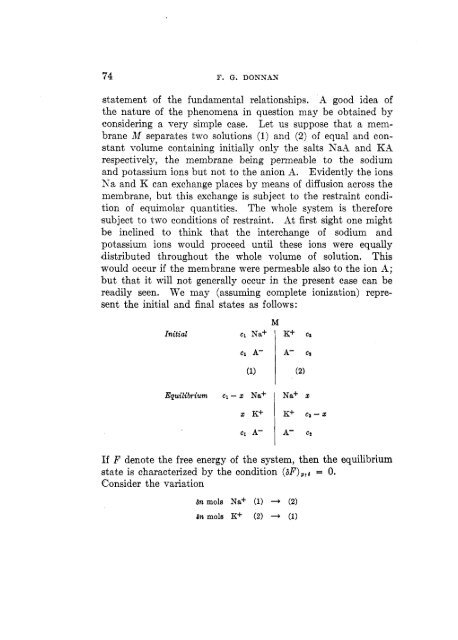The theory of membrane equilibria
The theory of membrane equilibria
The theory of membrane equilibria
Create successful ePaper yourself
Turn your PDF publications into a flip-book with our unique Google optimized e-Paper software.
74 I?. G. DONNAN<br />
statement <strong>of</strong> the fundamental relationships. A good idea <strong>of</strong><br />
the nature <strong>of</strong> the phenomena in question may be obtained by<br />
considering a very simple case. Let us suppose that a mem-<br />
brane M separates two solutions (1) and (2) <strong>of</strong> equal and con-<br />
stant volume containing initially only the salts NaL4 and KA<br />
respectively, the <strong>membrane</strong> being permeable to the sodium<br />
and potassium ions but not to the anion A. Evidently the ions<br />
Xa and K can exchange places by means <strong>of</strong> diffusion across the<br />
<strong>membrane</strong>, but this exchange is subject to the restraint condi-<br />
tion <strong>of</strong> equimolar quantities. <strong>The</strong> whole system is therefore<br />
subject to two conditions <strong>of</strong> restraint. At first sight one might<br />
be inclined to think that the interchange <strong>of</strong> sodium and<br />
potassium ions would proceed until these ions were equally<br />
distributed throughout the whole volume <strong>of</strong> solution. This<br />
would occur if the <strong>membrane</strong> were permeable also to the ion A;<br />
but that it will not generally occur in the present case can be<br />
readily seen. We may (assuming complete ionization) repre-<br />
sent the initial and final states as follows:<br />
Initial c1 Na+<br />
A-<br />
(1)<br />
Equilibrium CI-x Na+<br />
x K+<br />
~1 A-<br />
K+ CI<br />
A- Ca<br />
(2)<br />
Na+ x<br />
K+ ~ 3 - x<br />
A- ~2





